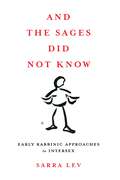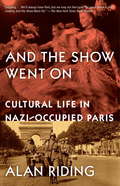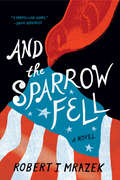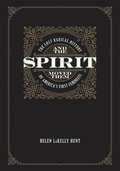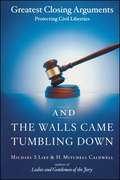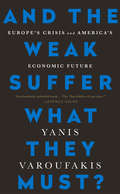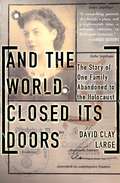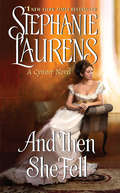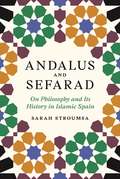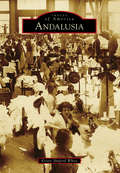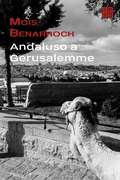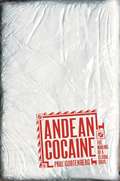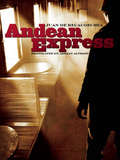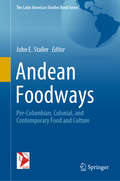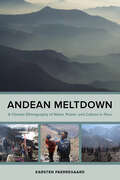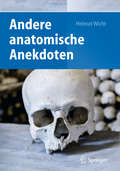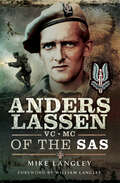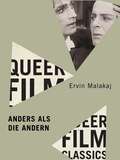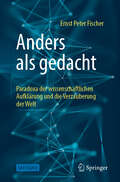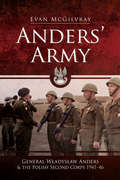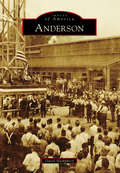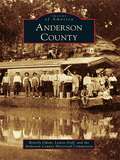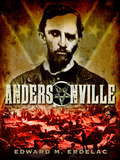- Table View
- List View
And the Sages Did Not Know: Early Rabbinic Approaches to Intersex
by Rabbi Sarra LevThis book explores the question: How did the rabbis of the first two centuries CE approach bodies that are born with variant genitals—bodies that they could not identify as definitely male or female? The rabbis had constructed a system in which every behavior was governed by one’s sex/gender, posing a conundrum both for people who did not fit into that model and for the rabbinic enterprise itself. Despite this, their texts contain dozens of references to intersex.And the Sages Did Not Know examines the rabbis’ legal texts and concludes that they had multiple approaches to intersex people. Sarra Lev analyzes seven different rabbinic responses to this conflict of their own making. Through their rulings on how intersex people should conduct themselves in multiple circumstances, the early rabbis treat intersex people as unidentifiable males or females, as indeterminate, as male, as non-gendered, as sui generis, as part-male/part-female, as a sustainable paradox, and, finally, as a way for them to think about gender, having nothing to do with intersex people themselves.This is the first such work that concentrates primarily on the potential effects of these rabbinic texts on intersex persons themselves rather than focusing on what the texts offer readers whose interest is rabbinic approaches to sex and gender or gender diversity. Although the rabbinic texts do not include the voices of known intersex people, these materials do offer us a window into how one small group of people approached intersex bodies, and how those approaches were both similar to and different from those we recognize today.
And the Sea Will Tell
by Vincent T. Bugliosi Bruce B. HendersonOnly the most adventuresome, or desperate, would plan an extended stay here. This is the true story of two men and two women who did. One married couple,two lovers. Four lives forever changed on an island that never wanted company. Each of the visitors sought escape from the world, but for very different reasons, their destinies intersecting on this deserted atoll. Not all of them would leave alive. The mystery shrouding their fate would be as dark and chilling as the ocean floor deep beneath Palmyra Island.
And the Show Went On: Cultural Life in Nazi-occupied Paris
by Alan RidingIn June 1940, Paris fell to the Nazis who made the world's cultural capital their favourite entertainment ground. Music halls and cabarets thrived during the occupation, providing plenty of work for actors, singers and musicians - except for Jews. The likes of Maurice Chevalier and Edith Piaf, who had entertained the French troops, now unabashedly provided amusement to the Germans. After the invasion of France, those artists still in Paris had to find ways to survive. Although Matisse and others kept out of view, Picasso could not avoid Nazi visitors. A few, like Beckett, joined the Resistance. Some were arrested and died in German hands. Others entertained the enemy. The theatres reopened, the movie cameras rolled, galleries sold paintings looted from Jewish families, pro-German writers and their rivals fought in print. Told through the experiences of renowned creative figures and witnesses of the times, And the Show Went On is an authoritative account of how Paris's artistic world lived through the Occupation, both of those who suffered Nazi oppression and those who prospered through collaboration.
And the Sparrow Fell: A Novel
by Robert J. MrazekAnd the Sparrow Fell is a coming-of-age tale set against the backdrop of the Vietnam War. Former U.S. Congressman Robert J. Mrazek tells the story of a wealthy family on the north shore of Long Island in the spring of 1967. Cornell undergraduate Rick Ledbetter goes through a rocky journey of self-discovery as both his family and his country disintegrate around him. Rick is a young rake in the mold of his father, Travis Ledbetter, a Medal of Honor–winning World War II navy pilot. Rick has been accepted into the swift boat program at Naval Officer Candidate School and will be heading for combat in Vietnam. Rick’s brother Tom, also a Cornell undergraduate, is a young man of true conscience who, because of his Christian faith, is morally opposed to the war. He has rejected conscientious-objector status. Rick meets and falls in love with Kate Kurshan, who is Tom’s girlfriend. She is also a Cornell student who opposes the war. Their three lives intersect as Rick, who becomes a war hero, discovers the human cost of war, while Tom, who has great moral courage, puts his life on the line in protest of the Vietnam War at a terrible personal cost.
And the Spirit Moved Them: The Lost Radical History of America's First Feminists
by Helen LaKelly HuntThe New York Times–bestselling author of Getting the Love You Want sends out a &‘call for renewed feminist action, based on &“the spirit and ethic of love&’&” (Kirkus Reviews). A decade before the Seneca Falls Convention, black and white women joined together at the 1837 Anti-Slavery Convention of American Women in the first instance of political organizing by American women for American women. Incited by &“holy indignation,&” these pioneers believed it was their God-given duty to challenge both slavery and patriarchy. Although the convention was largely written out of history for its religious and interracial character, these women created a blueprint for an intersectional feminism that was centuries ahead of its time. Part historical investigation, part personal memoir, Hunt traces how her research into nineteenth-century organizing led her to become one of the most significant philanthropists in modern history. Her journey to confront her position of power meant taking control of an oil fortune that was being deployed on her behalf but without her knowledge, and acknowledging the feminist faith animating her life&’s work.
And the Walls Came Tumbling Down: Greatest Closing Arguments Protecting Civil Liberties
by H. Mitchell Caldwell Michael S. LiefThe second volume in a must-have trilogy of the best closing arguments in American legal history Every day, Americans enjoy the freedom to decide what we do with our property, our bodies, our speech, and our votes. However, the rights to these freedoms have not always been guaranteed. Our civil rights have been assured by cases that have produced monumental shifts in America's cultural, political, and legal landscapes. And the Walls Came Tumbling Down showcases eight of the most exciting closing arguments in civil law -- from the Amistad case, in which John Quincy Adams brought the injustice of slavery to the center stage of American politics, to the Susan B. Anthony decision, which paved the way to success for women's suffrage, to the Larry Flynt trial, in which the porn king became an unlikely champion for freedom of speech. By providing historical and biographical details, as well as the closing arguments themselves, Lief and Caldwell give readers the background necessary to fully understand these important cases, bringing them vividly to life.
And the Weak Suffer What They Must?: Europe's Crisis and America's Economic Future
by Yanis VaroufakisA titanic battle is being waged for Europe's integrity and soul, with the forces of reason and humanism losing out to growing irrationality, authoritarianism, and malice, promoting inequality and austerity. The whole world has a stake in a victory for rationality, liberty, democracy, and humanism.In January 2015, Yanis Varoufakis, an economics professor teaching in Austin, Texas, was elected to the Greek parliament with more votes than any other member of parliament. He was appointed finance minister and, in the whirlwind five months that followed, everything he had warned about--the perils of the euro's faulty design, the European Union's shortsighted austerity policies, financialized crony capitalism, American complicity and rising authoritarianism--was confirmed as the "troika" (the European Central Bank, International Monetary Fund, and European Commission) stonewalled his efforts to resolve Greece's economic crisis. Here, Varoufakis delivers a fresh look at the history of Europe's crisis and America's central role in it. He presents the ultimate case against austerity, proposing concrete policies for Europe that are necessary to address its crisis and avert contagion to America, China, and the rest of the world. With passionate, informative, and at times humorous prose, he warns that the implosion of an admittedly crisis-ridden and deeply irrational European monetary union should, and can, be avoided at all cost.
And the World Closed Its Doors: The Story of One Family Abandoned to the Holocaust
by David Clay LargeMuch has been written about the West's unwillingness to attempt the rescue of tens of thousands of European Jews from the hands of the Nazis. Now David Clay Large gives a specific human face to this tragedy of bureaucratic inertia and ill will. In this masterpiece of Holocaust literature, Large tells the wrenching story of Max Schohl, a German Jew who in the years preceding World War II could not find a government that would allow his family to immigrate, despite wealth, education, business and family connections, a job offer from an American university, and herculean efforts by himself and his American relatives. After repeated but fruitless efforts to gain entry first to the United States, and then to Britain, Chile, and Brazil, Max died in Auschwitz, and his wife and daughters were sent to hard labor in Wiesbaden. Max left behind a unique collection of family letters and documents, which Large has brought together into a gripping, personal commentary on the evolution of the Holocaust in Europe and the hopelessly inadequate response from abroad.
And the World Went Dark: An Illustrated Interpretation of the Great War
by Steven N. PatriciaThis beautiful and evocative book gives an illustrated overview of the First World War, on land, on sea and in the air. With original drawings in full colour, Steven Patricia uses 30 years’ experience as a historical illustrator to give an informative and insightful account of the war, portraying the human faces of the participants and capturing moments in time with a vividness and immediacy that brings home both the emotional impact and the tragedy of war. Accompanied by soldier’s diary extracts and other contemporary literature, there are many drawings of the hardware of war: aircraft and airships, submarines and ships, guns and grenades. We also get a glimpse of weary officers relaxing in an RAF mess, see panicking sailors swimming desperately away from a sinking ship, soldiers stumbling across no-man’s land, and the dramatic scene of one of last great cavalry charges of any war, in Egypt. The role of animals is featured, including the importance of horses and rescue and messenger dogs. The text gives a concise introduction to the events of the war and why it started, with maps of the different fronts where fighting took place and a diagram of a trench system. Designed for readers with little familiarity of the conflict, this is a unique and unmissable book in the centenary of the ‘war to end all wars’.
And then She Fell (Cynster Sisters Series #4)
by Stephanie LaurensNo. 1 New York Times bestselling author Stephanie Laurens has returned to another utterly irresistible branch on her beloved Cynster family tree The only thing more troublesome than a Cynster man is a Cynster lady who believes that love is not her destiny. Famously known in London Society as 'The Matchbreaker', Henrietta Cynster's uncanny skill lies in preventing ill-fated nuptials - not in falling victim to Cupid's alluring spell. However, when she disrupts one match too many, she feels honour-bound to assist the dashing James Glossup and find him a suitable bride for a marriage of convenience. Yet this is no easy task. Complicated by the growing and undeniable attraction that flares between them, Henrietta must convince not only James, but herself, that when it comes to love, she will never, ever fall.
Andalus and Sefarad: On Philosophy and Its History in Islamic Spain (Jews, Christians, and Muslims from the Ancient to the Modern World #62)
by Sarah StroumsaAn integrative approach to Jewish and Muslim philosophy in al-AndalusAl-Andalus, the Iberian territory ruled by Islam from the eighth to the fifteenth centuries, was home to a flourishing philosophical culture among Muslims and the Jews who lived in their midst. Andalusians spoke proudly of the region's excellence, and indeed it engendered celebrated thinkers such as Maimonides and Averroes. Sarah Stroumsa offers an integrative new approach to Jewish and Muslim philosophy in al-Andalus, where the cultural commonality of the Islamicate world allowed scholars from diverse religious backgrounds to engage in the same philosophical pursuits.Stroumsa traces the development of philosophy in Muslim Iberia from its introduction to the region to the diverse forms it took over time, from Aristotelianism and Neoplatonism to rational theology and mystical philosophy. She sheds light on the way the politics of the day, including the struggles with the Christians to the north of the peninsula and the Fāṭimids in North Africa, influenced philosophy in al-Andalus yet affected its development among the two religious communities in different ways.While acknowledging the dissimilar social status of Muslims and members of the religious minorities, Andalus and Sefarad highlights the common ground that united philosophers, providing new perspective on the development of philosophy in Islamic Spain.
Andalusia (Images of America)
by Kristy Shuford WhiteAndalusia's destiny was determined by the Conecuh River, when the 1841 "Harrison Freshet" brought floods and mosquito fever to the original county seat of Montezuma, forcing the move to higher ground. The new site was named Andalusia, and the post office officially relocated in 1844. Like many small towns, Andalusia's destiny could have once again been determined by an outside force--the economy. However, from timber to textiles, Andalusia has chosen to fight back against abandonment and vacancy and can now truly boast a unique and viable commercial downtown that continues to flourish while preserving its historic structures. Andalusia was awarded the 2013 Quality of Life Award by The Alabama Municipal Journal for purchasing the old Alabama Textile Mill (Alatex) in 2009 and for partnering with the chamber of commerce to create a new chamber office, welcome center, and national textile monument in tribute to the thousands who worked at the site and in textile mills all over the United States.
Andaluso a Gerusalemme
by Mois Benarroch Erica MeleViaggio pieno di umorismo di uno scrittore spagnolo per le strade di Gerusalemme Uno scrittore di Madrid, nato a Lucena, arriva a un festival di scrittori a Gerusalemme, attraverso un libro tradotto anche in ebraico. È uno degli unici due stranieri non ebrei che arrivano alla fiera. Il narratore segue i suoi libri e i suoi scritti con stupore, i suoi amici criticano il viaggio in Israele. A Gerusalemme iniziano ad accadergli cose insolite e sconcertanti che non riesce a comprendere. Soffre di una specie di sindrome di Gerusalemme. In una delle stradine del centro della città, una donna afferma di essere sua madre ed è sicura che lui sia suo figlio, scomparso nella guerra del Libano, di cui nessuno ha più sentito parlare. Gli rivela di essere padre. Un gruppo di mistici lo sequestra e cerca di convincerlo a scrivere un articolo sul País sulla presenza ancestrale degli ebrei all'interno della città. Intanto intavola strane conversazioni con uno scrittore ebreo marocchino per le strade della città. Quando nulla ha più senso decide di tornare nella sua città, che, dopo tutto quello che ha passato, si scopre essere Parigi.
Andean Cocaine
by Paul GootenbergIlluminating a hidden and fascinating chapter in the history of globalization, Paul Gootenberg chronicles the rise of one of the most spectacular and now illegal Latin American exports: cocaine. Gootenberg traces cocaine's history from its origins as a medical commodity in the nineteenth century to its repression during the early twentieth century and its dramatic reemergence as an illicit good after World War II. Connecting the story of the drug's transformations is a host of people, products, and processes: Sigmund Freud, Coca-Cola, and Pablo Escobar all make appearances, exemplifying the global influences that have shaped the history of cocaine. But Gootenberg decenters the familiar story to uncover the roles played by hitherto obscure but vital Andean actors as well--for example, the Peruvian pharmacist who developed the techniques for refining cocaine on an industrial scale and the creators of the original drug-smuggling networks that decades later would be taken over by Colombian traffickers. Andean Cocaine proves indispensable to understanding one of the most vexing social dilemmas of the late twentieth-century Americas: the American cocaine epidemic of the 1980s and, in its wake, the seemingly endless U.S. drug war in the Andes.
Andean Express
by Juan de RecacoecheaThis moody murder mystery set during an overnight train journey in 1950s South America &“delights like strong coffee savored in a cosmopolitan cafe&” (Publishers Weekly). In 1952, a train makes its way from La Paz, Bolivia, to the Chilean seaport of Arica. Among the passengers are: a businessman with his much-younger wife, a man in priest&’s garb hiding a secret, Irish and Russian expatriates, a miner, and a student. Before the trip is over, there will be many revelations—including the identity of a killer. From the author of American Visa, a winner of Bolivia&’s National Book Prize, this atmospheric novel is &“part social commentary, part mystery thriller . . . A chilling, tragic tale&” (MultiCultural Review).
Andean Foodways: Pre-Columbian, Colonial, and Contemporary Food and Culture (The Latin American Studies Book Series)
by John E. StallerThere is widespread acknowledgement among anthropologists, archaeologists, ethnobotanists, as well as researchers in related disciplines that specific foods and cuisines are linked very strongly to the formation and maintenance of cultural identity and ethnicity. Strong associations of foodways with culture are particularly characteristic of South American Andean cultures. Food and drink convey complex social and cultural meanings that can provide insights into regional interactions, social complexity, cultural hybridization, and ethnogenesis. This edited volume presents novel and creative anthropological, archaeological, historical, and iconographic research on Andean food and culture from diverse temporal periods and spatial settings. The breadth and scope of the contributions provides original insights into a diversity of topics, such as the role of food in Andean political economies, the transformation of foodways and cuisines through time, and ancient iconographic representations of plants and animals that were used as food. Thus, this volume is distinguished from most of the published literature in that specific foods, cuisines, and culinary practices are the primary subject matter through which aspects of Andean culture are interpreted.
Andean Meltdown: A Climate Ethnography of Water, Power, and Culture in Peru
by Karsten PaerregaardAndean Meltdown examines how climate change and its consequences for Peru's glaciers are affecting the country's water supply and impacting Andean society and culture in unprecedented ways. Drawing on forty years of extensive research, relationship building, and community engagement in Peru, Karsten Paerregaard provides an ethnographic exploration of Andean ritual practices and performances in the context of an altered climate. By documenting Andean peoples' responses to rapid glacier retreat and urgent water shortages, Paerregaard considers the myriad ways climate change intersects with environmental, social, and political change. A pathbreaking contribution to cultural anthropology and environmental humanities, Andean Meltdown challenges prevailing theoretical thinking about the culture-nature nexus and offers a new perspective on Andean peoples' understanding of their role as agents in the shifting relationship between humans and nonhumans.
Andere anatomische Anekdoten
by Helmut WichtDer Autor ist ein Anatom, dem so mancherlei durch den Kopf geht, und eh' er es vergisst, schreibt er's auf. Oft sind es melancholische Gedanken, manchmal garstige, und manchmal welche, die er erheiternd findet. Versuchen Sie, die Geschichten als "Miniaturen" zu lesen. Filigrane, oft ein wenig umständliche und versponnene Spielereien über ein Thema, einen Gedanken, eine Beobachtung, ein Wort. Stimmungsbilder. Nehmen Sie das Büchlein nicht allzu ernst - das ist kein Sachbuch, kein Pamphlet, der Autor hat kein Anliegen, hat nicht die Absicht, Sie zu lehren. Er will Sie unterhalten, vielleicht hie und da verwundern und Ihnen die Anatomie als etwas näherbringen, was sie auch ist: ein ästhetisches, ein sprachverliebtes Fach. Nehmen Sie es doch ernst - was hier drinnen steht, ist wahr. Wahr in dem Sinne, dass die anatomischen und sonstigen wissenschaftlichen Sachverhalte, von denen die Rede sein wird, bis ins Detail so sind, wie sie beschrieben werden; wahr in dem Sinne, dass die Ereignisse, die geschildert werden, sich wirklich so ähnlich ereignet haben.
Anders Lassen VC, MC, of the SAS
by Mike LangleyThe dramatic true story of the heroic Danish World War II soldier who received Britain&’s highest military honor. The story of Anders Lassen is one of the most amazing of the Second World War—indeed in the history of the British armed services. From the day he stalked and killed a stag armed only with a knife, Lassen had been recognized as unique. He took part in a series of extraordinary strikes against the Axis powers in West Africa, Normandy, the Channel Islands, the Aegean and Greece, the Balkans, and, finally, Italy. This biography of a remarkable warrior is based on interviews with Lassen&’s fellow soldiers and a wealth of original research. It covers each stage of Lassen&’s short, brilliant career in vivid detail and offers a penetrating insight into the exceptional courage, confidence, and single-minded motivation that lay behind Lassen&’s extraordinary exploits. Mike Langley also reconstructs, using the testimony of survivors, the operation in which Lassen was killed—and for which he was posthumously awarded the Victoria Cross.
Anders als die Andern (Queer Film Classics #7)
by Ervin MalakajReleased in 1919, Anders als die Andern (Different from the Others) stunned audiences with its straightforward depiction of queer love. Supporters celebrated the film’s moving storyline, while conservative detractors succeeded in prohibiting public screenings. Banned and partially destroyed after the rise of Nazism, the film was lost until the 1970s and only about one-third of its original footage is preserved today.Directed by Richard Oswald and co-written by Oswald and the renowned sexologist Magnus Hirschfeld, Anders als die Andern is a remarkable artifact of cinema culture connected to the vibrant pre-Stonewall homosexual rights movement of early-twentieth-century Germany. The film makes a strong case for the normalization of homosexuality and for its decriminalization, but the central melodrama still finds its characters undone by their public outing. Ervin Malakaj sees the film’s portrayal of the pain of living life queerly as generating a complex emotional identification in modern spectators, even those living in apparently friendlier circumstances. There is a strange comfort in knowing that we are not alone in our struggles, and Malakaj recuperates Anders als die Andern’s mournful cinema as an essential element of its endurance, treating the film’s melancholia both as a valuable feeling in and of itself and as a springboard to engage in an intergenerational queer struggle.Over a century after the film’s release, Anders als die Andern serves as a stark reminder of how hostile the world can be to queer people, but also as an object lesson in how to find sustenance and social connection in tragic narratives.
Anders als gedacht – Paradoxa der wissenschaftlichen Aufklärung und die Verzauberung der Welt
by Ernst Peter Fischer„Das Programm der Aufklärung war die Entzauberung der Welt“, wie Max Horkheimer und Theodor W. Adorno in ihren philosophischen Fragmenten geschrieben haben. Die Aufklärung sollte die Welt berechenbar machen und ihr jedes Geheimnis nehmen, wie es Soziologen seit Max Weber gedacht und gewünscht haben. Dieses Vorhaben ist gründlich gescheitert, wie dieses Buch eindrucksvoll zeigt. Die wissenschaftliche Aufklärung hat zu Paradoxien geführt und mit ihnen die Welt verzaubert. Anhand zahlreicher Beispiele – vom Licht über Atome und Gene bis hin zum Leben selbst – wird dies anschaulich dargestellt. Sie alle bestätigen die Weisheit von Wilhelm Busch, „Erstens kommt es anders, und zweitens als man denkt“, und diese Worte versprechen den Menschen eine offene Welt. Die Wissenschaft hat stets vernünftige Fragen gestellt, „Was ist Licht?“, und gibt darauf vernünftige Antworten: Licht ist eine elektromagnetische Welle. Doch Licht kann auch als Teilchen in Erscheinung treten, was es zu einem anhaltenden Geheimnis macht. Dasselbe gilt für Atome, Gene und das Leben allgemein. Die Wissenschaft verwandelt auf diese Weise das Gewohnte in das Mysteriöse, und sie romantisiert damit die Welt. Während die Aufklärung ihre Objekte wörtlich feststellen wollte, hält das romantische Denken die Dinge in Bewegung. In der Welt kommt es nicht auf ein abgeschlossenes Sein, sondern auf ein offenes Werden an.
Anders' Army: General Wladyslaw Anders and the Polish Second Corps, 1941-46
by Evan McGilvrayAlong with thousands of his compatriots, Wladyslaw Anders was imprisoned by the Soviets when they attacked Poland with their German allies in 1939. They endured terrible treatment until the German invasion of the Soviet Union in 1941 suddenly put Stalin in the Allied camp, after which they were evacuated to Iran and formed into the Polish Second Corps under Anders command.Once equipped and trained, the corps was eventually committed to the Italian campaign, notably at Monte Cassino. The author assesses Anders performance as a military commander, finding him merely adequate, but his political role was more significant and caused friction in the Allied camp. From the start he often opposed Sikorski, the Polish Prime Minister in exile and Commander in Chief of Polish armed forces in the West. Indeed, Anders was suspected of collusion in Sikorskis death in July 1943 and of later sending Polish death squads into Poland to eliminate opponents, charges that Evan McGilvray investigates. Furthermore, Anders voiced his deep mistrust of Stalin and urged a war against the Soviets after the defeat of Hitler.
Anderson (Images of America)
by David HumphreyThe city of Anderson is named after Chief William Anderson, whose Indian name was Kikthawenund, meaning "making a noise" or "causing to crack." Early settlers referred to the area as Anderson Town, while the Moravian missionaries called it "The Heathen Town Four Miles Away." It later became Anderstown before the Indiana State Legislature shortened the name to Anderson in 1844. In the spring of 1887, natural gas was discovered in the city. Several industries came to the area, leading to a population explosion. Anderson soon became a "factory town," with General Motors building plants throughout the city. The success of the automobile factories attracted entrepreneurs and made Anderson the economic center of Madison County. From the 1940s through the 1970s, downtown Anderson had its share of family-owned businesses as well as national chain stores like J.C. Penney, Sears & Roebuck, and Montgomery Ward. Today, it remains filled with a rich heritage and continues to grow in a new economic market.
Anderson County
by Anderson County Historical Commission Beverly OdomFrom its roots in the unbroken wilderness of central East Texas, Anderson County has overcome many adversities to become the crossroads of East Texas. In the 1830s, rugged pioneers came to the fertile Trinity River Valley to carve out a place for themselves from the untamed country. These pioneers began a settlement along a stream about 10 miles east of the Trinity River in what would become Anderson County. Other families joined their effort, and Fort Houston was soon built in 1835-1836 to protect settlers from the dangers inherent to the wild frontier. Lost in the passage of time, many communities no longer exist. Today the principal towns are Palestine, Frankston, and Elkhart, but many other communities contribute to the quality of life across the county.
Andersonville
by Edward M ErdelacReaders of Stephen King and Joe Hill will devour this bold, terrifying new novel from Edward M. Erdelac. A mysterious man posing as a Union soldier risks everything to enter the Civil War's deadliest prison--only to find a horror beyond human reckoning. Georgia, 1864. Camp Sumter, aka Andersonville, has earned a reputation as an open sewer of sadistic cruelty and terror where death may come at any minute. But as the Union prisoners of war pray for escape, cursing the fate that spared them a quicker end, one man makes his way into the camp purposefully. Barclay Lourdes has a mission--and a secret. But right now his objective is merely to survive the hellish camp. The slightest misstep summons the full fury of the autocratic commander, Captain Wirz, and the brutal Sergeant Turner. Meanwhile, a band of shiftless thieves and criminals known as the "Raiders" preys upon their fellow prisoners. Barclay soon finds that Andersonville is even less welcoming to a black man--especially when that man is not who he claims to be. Little does he imagine that he's about to encounter supernatural terrors beyond his wildest dreams . . . or nightmares.Advance praise for Andersonville "Erdelac makes a heady brew out of dreadful true events, angel and demon lore, secret societies, and the trappings of Southern gothic novels. This is thoughtful horror at its best, and not at all for the faint of heart."--Publishers Weekly (starred review)"The true story of Andersonville is one of unimaginable horror and human misery. It's a testament to his unmatched skill as a storyteller that Edward M. Erdelac is not only able to capture that horror but to add another level of supernatural terror and reveal that the darkest evil of all resides in the human soul. Highly recommended to fans of horror and history alike."--Brett J. Talley, Bram Stoker Award-nominated author of That Which Should Not Be and He Who Walks in Shadow "Andersonville is a raw, groundbreaking supernatural knuckle-punch. Erdelac absolutely owns Civil War and Wild West horror fiction."--Weston Ochse, bestselling author of SEAL Team 666"Edward M. Erdelac is a master of historical reinvention. In Andersonville, he peels away the façade of history to reveal the horror and sacrifices that led to the end of the Civil War. Clandestine operations, mystical battles waged unseen, and unlikely heroes combine to save a nation, not only from itself but from the demonic forces threatening to tear the whole of existence asunder. Forget what you know about the War Between the States, this is the story we should have been taught."--Tim Marquitz, author of the Demon Squad series"If you took a tale of atmospheric horror by Ambrose Bierce and infused it with the energy of Elmore Leonard, you would come close to what Edward Erdelac has accomplished with Andersonville. But even that combination would sell the novel short. What Erdelac has done is not just splice genres together but create his own voice in telling of the horrors, real and supernatural, inhabiting the most infamous prison camp of the Civil War. This is U.S. history seen through the eyes of the tortured dead, told with amazing skill by an author who knows how to create genre literature with a purpose."--C. Courtney Joyner, author of Shotgun and Nemo Rising
